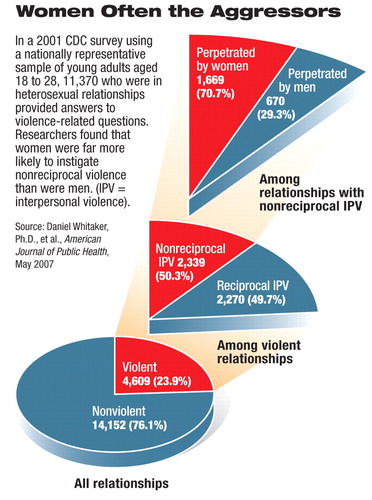Men Shouldn't Be Overlooked as Victims of Partner Violence
Women are doing virtually everything these days that men are—working as doctors, lawyers, and rocket scientists; flying helicopters in combat; riding horses in the Kentucky Derby. And physically assaulting their spouses or partners.
In fact, when it comes to nonreciprocal violence between intimate partners, women are more often the perpetrators.
These findings on intimate partner violence come from a study conducted by scientists at the Centers for Disease Control and Prevention (CDC). The lead investigator was Daniel Whitaker, Ph.D., a behavioral scientist and team leader at the National Center for Injury Prevention and Control (which is part of the CDC). Results were published in the May Journal of Public Health.
In 2001, the National Longitudinal Study of Adolescent Health attempted to amass data about the health of a nationally representative sample of 14,322 individuals between the ages of 18 and 28. The study also asked subjects to answer questions about romantic or sexual relationships in which they had engaged during the previous five years and whether those relationships had involved violence.
Of those subjects, 11,370 reported having had heterosexual relationships and also provided answers to the violence-related questions. So Whitaker and his colleagues decided to use the responses from these 11,370 subjects for a study into how much violence is experienced in intimate heterosexual partner relationships, who the instigators are, and whether physical harm accrues from the violence.
The 11,370 subjects, Whitaker and his colleagues found, reported on 18,761 relationships, of which 76 percent had been nonviolent and 24 percent violent. That almost a quarter of the subjects had engaged in violent relationships may seem high to some people, but “the rates we found are similar to those of other studies of late adolescents and young adults, a time period when interpersonal-violence rates are at their highest,” Whitaker told Psychiatric News. Also, he added, “these rates demonstrate the magnitude of interpersonal violence as a health and social problem.”

Furthermore, Whitaker discovered, of the 24 percent of relationships that had been violent, half had been reciprocal and half had not. Although more men than women (53 percent versus 49 percent) had experienced nonreciprocal violent relationships, more women than men (52 percent versus 47 percent) had taken part in ones involving reciprocal violence.
Regarding perpetration of violence, more women than men (25 percent versus 11 percent) were responsible. In fact, 71 percent of the instigators in nonreciprocal partner violence were women. This finding surprised Whitaker and his colleagues, they admitted in their study report.
As for physical injury due to intimate partner violence, it was more likely to occur when the violence was reciprocal than nonreciprocal. And while injury was more likely when violence was perpetrated by men, in relationships with reciprocal violence it was the men who were injured more often (25 percent of the time) than were women (20 percent of the time). “This is important as violence perpetrated by women is often seen as not serious,” Whitaker and his group stressed.
Of the study's numerous findings, Whitaker said, “I think the most important is that a great deal of interpersonal violence is reciprocally perpetrated and that when it is reciprocally perpetrated, it is much more likely to result in injury than when perpetrated by only one partner.”
The National Longitudinal Study of Adolescent Health, upon which this investigation was based, was funded by the National Institute of Child Health and Human Development with co-funding from 17 other federal agencies.
An abstract of “Differences in Frequency of Violence and Reported Injury Between Relationships With Reciprocal and Nonreciprocal Intimate Partner Violence” is posted at<www.ajph.org/cgi/content/abstract/97/5/941>.▪



